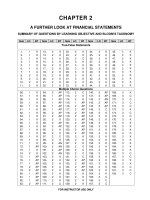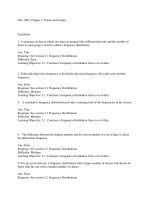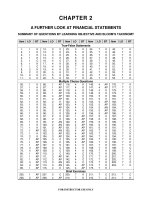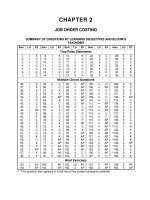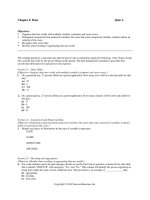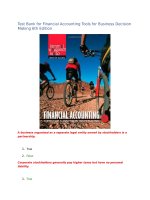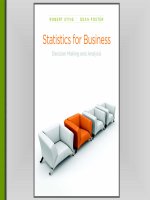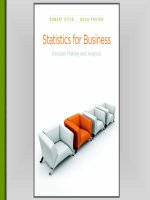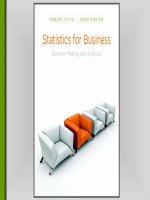Statistics for business decision making and analysis robert stine and foster chapter 15
Bạn đang xem bản rút gọn của tài liệu. Xem và tải ngay bản đầy đủ của tài liệu tại đây (297.45 KB, 41 trang )
Chapter 15
Confidence Intervals
Copyright © 2011 Pearson Education, Inc.
15.1 Ranges for Parameters
Before deciding to offer an affinity credit card
to alumni of a university, the credit
company wants to know how many
customers will accept the offer and how
large a balance they will carry?
Use confidence intervals to answer such questions
They convey information about the precision of the
estimates
3 of 41
Copyright © 2011 Pearson Education, Inc.
15.1 Ranges for Parameters
Two Parameters of Interest
p, the proportion who will return the application for the
credit card
µ, the average monthly balance that those who accept the
credit card will carry
4 of 41
Copyright © 2011 Pearson Education, Inc.
15.1 Ranges for Parameters
Summary Statistics (n = 1000)
5 of 41
Copyright © 2011 Pearson Education, Inc.
15.1 Ranges for Parameters
Confidence Interval for the Proportion
A confidence interval is a range of plausible values for a
parameter based on a sample.
Constructing confidence intervals relies on the sampling
distribution of the statistic.
6 of 41
Copyright © 2011 Pearson Education, Inc.
15.1 Ranges for Parameters
Confidence Interval for the Proportion
The Central Limit Theorem implies a normal model for the
sampling distribution of .
ˆ
p
E( ) = p and SE(
ˆ
p
)=
ˆ
p
p (1 − p ) / n
7 of 41
Copyright © 2011 Pearson Education, Inc.
15.1 Ranges for Parameters
95% Confidence Interval for p
The sample statistic in 95% of samples lies within 1.96
standard errors of the population parameter.
8 of 41
Copyright © 2011 Pearson Education, Inc.
15.1 Ranges for Parameters
95% Confidence Interval for p
For any of these samples, the interval formed by reaching
1.96 standard errors to the left and right of will contain
p. p
ˆ
The estimated standard error (se) is used in constructing
the confidence interval (i.e., is substituted for p).
ˆ
p
9 of 41
Copyright © 2011 Pearson Education, Inc.
15.1 Ranges for Parameters
95% Confidence Interval for p
The 100(1 – α)% confidence interval for p is
pˆ − za /2 pˆ ( 1 − pˆ ) / n to pˆ + za /2 pˆ ( 1 − pˆ ) / n
For a 95% confidence interval zα/2 = 1.96.
10 of 41
Copyright © 2011 Pearson Education, Inc.
15.1 Ranges for Parameters
Checklist for Confidence Interval for p
SRS condition. The sample is a simple random sample
from the relevant population.
Sample size condition (for proportion). Both n
and n
are larger than 10.
(1 − pˆ )
ˆ
p
11 of 41
Copyright © 2011 Pearson Education, Inc.
15.1 Ranges for Parameters
Credit Card Example
The estimated standard error is
se( ˆ) =
p
•
= 0.01097
0.14(1 − 0.14
)
1000
The 95% confidence interval is
0.14 ± 1.96(0.01097) = [0.1185 to 0.1615]
12 of 41
Copyright © 2011 Pearson Education, Inc.
15.1 Ranges for Parameters
Credit Card Example
With 95% confidence, the population proportion that will
accept the offer is between about 12% and 16%.
A larger sample size will reduce the estimated standard
error resulting in a narrower interval
(a more precise estimate of p).
13 of 41
Copyright © 2011 Pearson Education, Inc.
15.2 Confidence Interval for the Mean
Confidence Interval for µ
A similar procedure as that used for p is used to construct
a confidence interval for µ.
The estimated standard error for
se(
)=s/
X
is used.
X
n
14 of 41
Copyright © 2011 Pearson Education, Inc.
15.2 Confidence Interval for the Mean
Student’s t-Distribution
Used because we substitute s for σ in the estimated
standard error.
A parameter called degrees of freedom (df = n-1) controls
the shape of the distribution.
As n increases, the t-distribution more closely resembles
the standard normal distribution.
15 of 41
Copyright © 2011 Pearson Education, Inc.
15.2 Confidence Interval for the Mean
Student’s t-Distribution
Standard normal (black) and Student’s t-distributions (red)
16 of 41
Copyright © 2011 Pearson Education, Inc.
15.2 Confidence Interval for the Mean
Confidence Interval for µ
The 100(1 – α)% confidence interval for µ is
x
- tα/2, n-1 s /
to
n
+ t α/2, n-1 s /
x
.
n
The value of t depends on the level of confidence and n – 1
degrees of freedom.
17 of 41
Copyright © 2011 Pearson Education, Inc.
15.2 Confidence Interval for the Mean
Checklist for Confidence Interval for µ
SRS condition. The sample is a simple random sample
from the relevant population.
Sample size condition. The sample size is larger than 10
times the squared skewness and 10 times the absolute
value of the kurtosis.
18 of 41
Copyright © 2011 Pearson Education, Inc.
15.2 Confidence Interval for the Mean
Percentiles of the t-Distribution
The t value for 95% confidence and 139 df = 1.98.
19 of 41
Copyright © 2011 Pearson Education, Inc.
15.2 Confidence Interval for the Mean
Credit Card Example
The estimated standard error is
se (
) = $2,833.33 /
X
= $239.46
140
The 95% confidence interval is
$1,990.50 ± 1.98($239.46)
[$1,516.37 to $2,464.63]
20 of 41
Copyright © 2011 Pearson Education, Inc.
15.2 Confidence Interval for the Mean
Credit Card Example
•
We are 95% confident that µ lies between $1,516.37 and
$2,464.63.
•
Might µ be $1,250? It could be, but based on the sample
results it’s not likely.
21 of 41
Copyright © 2011 Pearson Education, Inc.
15.3 Interpreting Confidence Intervals
Common Confusions: Wrong Interpretations
95% of all customers keep a balance of $1,520 to
$2,460.
The mean balance of 95% of samples of 140 accounts will
fall between $1,520 and $2,460.
The mean balance is between $1,520 and $2,460.
22 of 41
Copyright © 2011 Pearson Education, Inc.
15.4 Manipulating Confidence Intervals
Obtaining Ranges for Related Quantities
If [L to U] is a 100(1 – α)% confidence interval for µ,
then [c x L to c x U] is a 100 (1 – α)% confidence interval
for c x µ and [c + L to c + U] is a
100(1 – α)% confidence interval for c + µ.
23 of 41
Copyright © 2011 Pearson Education, Inc.
15.4 Manipulating Confidence Intervals
Changing the Problem
Creating a new variable is preferable to combining
confidence intervals.
Consider the following:
Let Y = profit earned from each customer. A
customer who does not accept the card costs
the bank $8. Each customer who accepts the
card costs the bank $58 but the bank earns
10% on the revolving credit card balance.
24 of 41
Copyright © 2011 Pearson Education, Inc.
15.4 Manipulating Confidence Intervals
Creating a New Variable
Therefore, profit ($) earned from a customer is
yi =
-8 if offer is not accepted
0.10 (Balance) – 58 if offer is accepted.
25 of 41
Copyright © 2011 Pearson Education, Inc.

